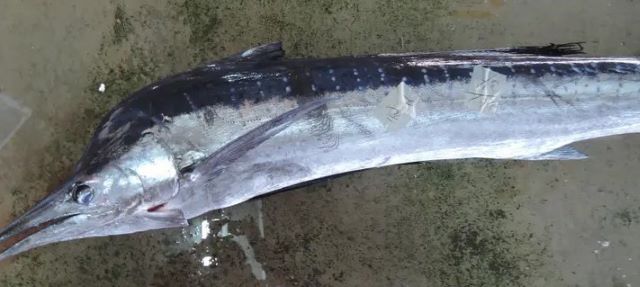
The appearance of Indo-Pacific blue marlin (Kurokajiki)
Common name: Indo-Pacific blue marlin, Billfish, Blue Marlin, Cuban Black Marlin, Pacific blue marlin, Blue marlin fish, Cuban blue marlin, Marlin, Atlantic Blue Marlin
Japanese name: Kurokajiki (黒旗魚、黒皮旗魚)
Taiwan common name: 黑皮旗魚、黑皮仔、鐵皮、丁挽、油旗魚、鐵皮丁挽、烏皮
Chinese common name: 大西洋蓝枪鱼
Korean common name: 대서양블루마린
French common name: Espadon, Makaire bleu
German common name: Blauer Marlin
Italian common name: Augghia ‘mperiali
Spanish common name: Abanico, Aguja, Aguja azul, Aguja azul del Atlantico, Aguja casta, Aguja de casta, Aguja negra, Castero
Portuguese common name: Agulhao preto, Agulhão, Agulhão preto, Agulhão-azul, Agulhão-negro, Agulhão-roliço, Atum, Espadarte, Espadarte-preto, Espadarte-sombra, Espadim, Espadim azul, Espadim-azul do Atlântico, Espadium azul do Atlantico
Scientific name: Makaira nigricans Lacepède, 1802
Nigiri sushi detail: Indo-Pacific blue marlin (Kurokajiki) Nigiri sushi
Characteristics:
Indo-Pacific blue marlin (Kurokajiki) is distributed in the temperate and tropical waters of the Indo-Pacific Ocean and southern Japan. It inhabits the surface layer of the open ocean. The length of the body is 2~3 m, and the maximum length is 4.5 m. The body color is blackish purple on the dorsal side and silvery white on the ventral side, with more than a dozen cobalt-colored lateral stripes on the body. The season is from April to May.
It is highly valued as the main target in the sport fishing community, but its commercial value is relatively low.
Half of the catch is bycatch from longlines targeting tuna and Broadbill swordfish (Mekajiki) ki. Once an ingredient in fish sausages and other fish paste products, it is now used as fresh fish. Its flesh is lean with slightly less fat and lighter in color. Although inferior to Mekajiki, which is considered the best marlin in flavor and meat quality, it is suitable for sashimi, steaks, and other dishes such as Kasuzuke (marinated in sake lees) and Misozuke (marinated in soybean paste).